Business Report: Procurement Management Analysis of WiFi Reach Project
VerifiedAdded on 2020/06/04
|12
|3793
|667
Report
AI Summary
This report provides a comprehensive analysis of procurement management, using the WiFi Reach Project as a case study. It begins with an introduction to procurement and then identifies four key problem areas: procurement cost, stakeholder management, selection of strategy, and training issues. The report then evaluates the type of contract used, which was a Firm Fixed Price contract, and discusses its advantages and disadvantages. Recommendations are provided to address the identified problems, including proper budget planning, stakeholder management, and strategic planning. The report concludes with an action plan to ensure the effective and efficient completion of the WiFi Reach Project. The report also highlights the importance of clear communication and coordination among stakeholders to mitigate project delays and ensure successful implementation. Finally, the report suggests that the contract terms should be modified to address the training issues and provide the necessary support to the staff and doctors.
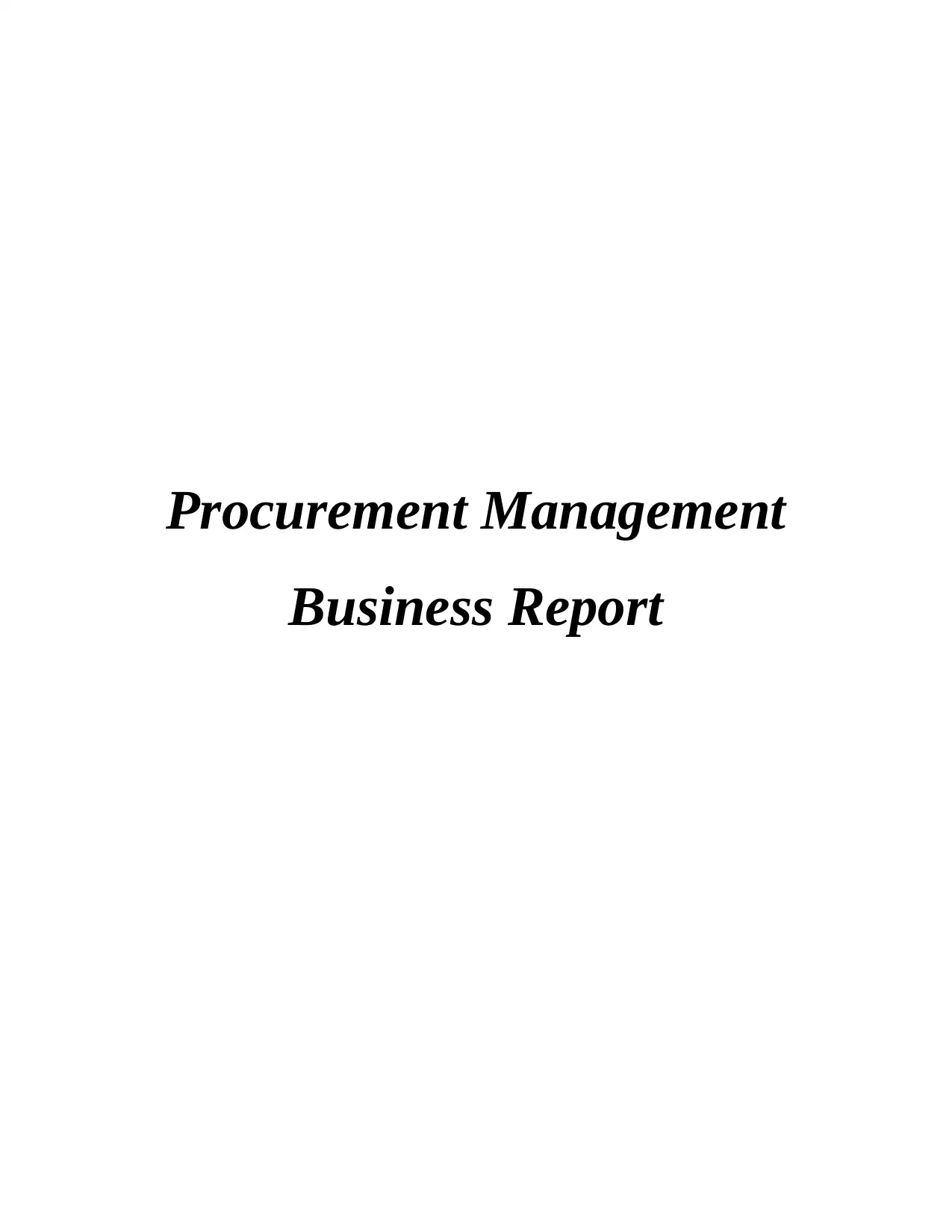
Procurement Management
Business Report
Business Report
Paraphrase This Document
Need a fresh take? Get an instant paraphrase of this document with our AI Paraphraser
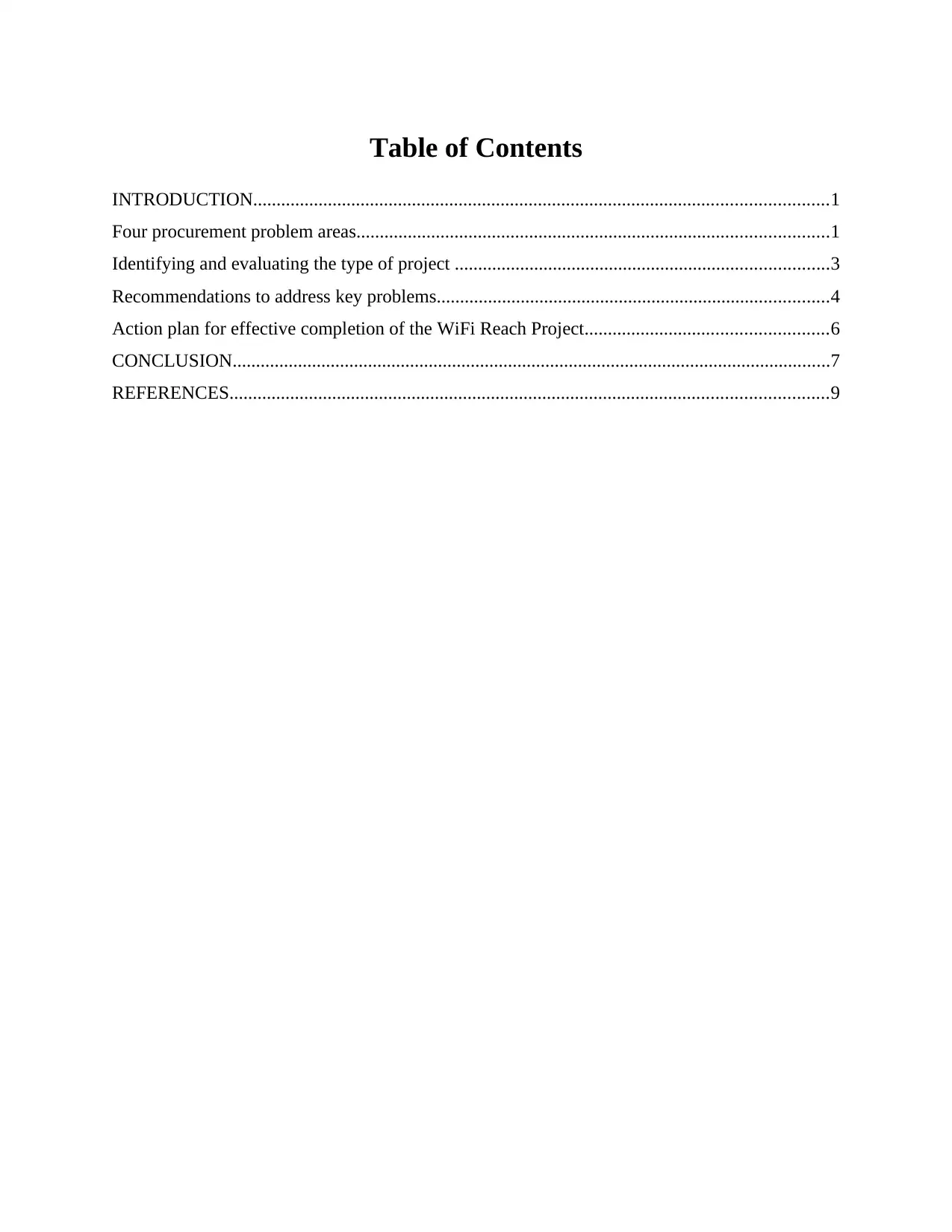
Table of Contents
INTRODUCTION...........................................................................................................................1
Four procurement problem areas.....................................................................................................1
Identifying and evaluating the type of project ................................................................................3
Recommendations to address key problems....................................................................................4
Action plan for effective completion of the WiFi Reach Project....................................................6
CONCLUSION................................................................................................................................7
REFERENCES................................................................................................................................9
INTRODUCTION...........................................................................................................................1
Four procurement problem areas.....................................................................................................1
Identifying and evaluating the type of project ................................................................................3
Recommendations to address key problems....................................................................................4
Action plan for effective completion of the WiFi Reach Project....................................................6
CONCLUSION................................................................................................................................7
REFERENCES................................................................................................................................9
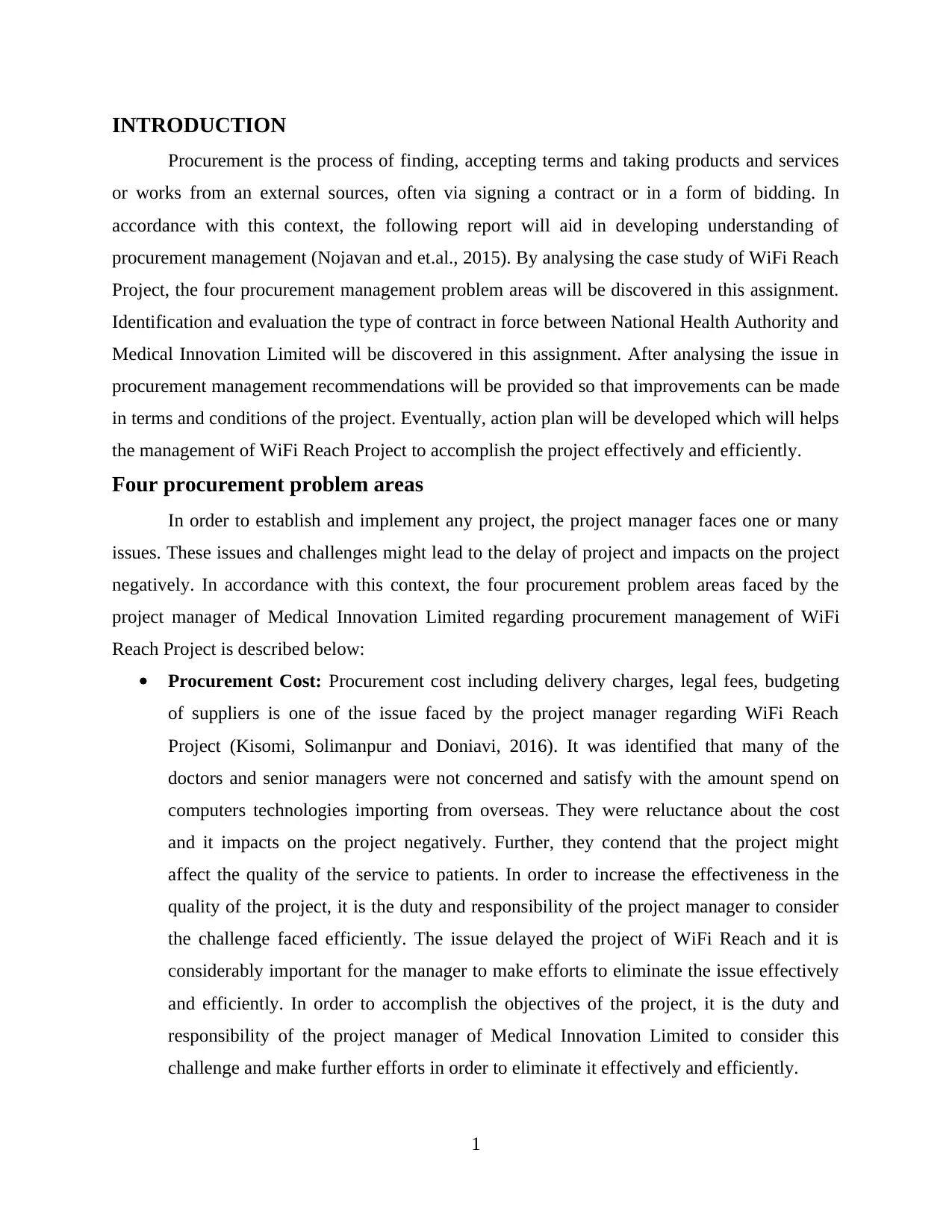
INTRODUCTION
Procurement is the process of finding, accepting terms and taking products and services
or works from an external sources, often via signing a contract or in a form of bidding. In
accordance with this context, the following report will aid in developing understanding of
procurement management (Nojavan and et.al., 2015). By analysing the case study of WiFi Reach
Project, the four procurement management problem areas will be discovered in this assignment.
Identification and evaluation the type of contract in force between National Health Authority and
Medical Innovation Limited will be discovered in this assignment. After analysing the issue in
procurement management recommendations will be provided so that improvements can be made
in terms and conditions of the project. Eventually, action plan will be developed which will helps
the management of WiFi Reach Project to accomplish the project effectively and efficiently.
Four procurement problem areas
In order to establish and implement any project, the project manager faces one or many
issues. These issues and challenges might lead to the delay of project and impacts on the project
negatively. In accordance with this context, the four procurement problem areas faced by the
project manager of Medical Innovation Limited regarding procurement management of WiFi
Reach Project is described below:
Procurement Cost: Procurement cost including delivery charges, legal fees, budgeting
of suppliers is one of the issue faced by the project manager regarding WiFi Reach
Project (Kisomi, Solimanpur and Doniavi, 2016). It was identified that many of the
doctors and senior managers were not concerned and satisfy with the amount spend on
computers technologies importing from overseas. They were reluctance about the cost
and it impacts on the project negatively. Further, they contend that the project might
affect the quality of the service to patients. In order to increase the effectiveness in the
quality of the project, it is the duty and responsibility of the project manager to consider
the challenge faced efficiently. The issue delayed the project of WiFi Reach and it is
considerably important for the manager to make efforts to eliminate the issue effectively
and efficiently. In order to accomplish the objectives of the project, it is the duty and
responsibility of the project manager of Medical Innovation Limited to consider this
challenge and make further efforts in order to eliminate it effectively and efficiently.
1
Procurement is the process of finding, accepting terms and taking products and services
or works from an external sources, often via signing a contract or in a form of bidding. In
accordance with this context, the following report will aid in developing understanding of
procurement management (Nojavan and et.al., 2015). By analysing the case study of WiFi Reach
Project, the four procurement management problem areas will be discovered in this assignment.
Identification and evaluation the type of contract in force between National Health Authority and
Medical Innovation Limited will be discovered in this assignment. After analysing the issue in
procurement management recommendations will be provided so that improvements can be made
in terms and conditions of the project. Eventually, action plan will be developed which will helps
the management of WiFi Reach Project to accomplish the project effectively and efficiently.
Four procurement problem areas
In order to establish and implement any project, the project manager faces one or many
issues. These issues and challenges might lead to the delay of project and impacts on the project
negatively. In accordance with this context, the four procurement problem areas faced by the
project manager of Medical Innovation Limited regarding procurement management of WiFi
Reach Project is described below:
Procurement Cost: Procurement cost including delivery charges, legal fees, budgeting
of suppliers is one of the issue faced by the project manager regarding WiFi Reach
Project (Kisomi, Solimanpur and Doniavi, 2016). It was identified that many of the
doctors and senior managers were not concerned and satisfy with the amount spend on
computers technologies importing from overseas. They were reluctance about the cost
and it impacts on the project negatively. Further, they contend that the project might
affect the quality of the service to patients. In order to increase the effectiveness in the
quality of the project, it is the duty and responsibility of the project manager to consider
the challenge faced efficiently. The issue delayed the project of WiFi Reach and it is
considerably important for the manager to make efforts to eliminate the issue effectively
and efficiently. In order to accomplish the objectives of the project, it is the duty and
responsibility of the project manager of Medical Innovation Limited to consider this
challenge and make further efforts in order to eliminate it effectively and efficiently.
1
⊘ This is a preview!⊘
Do you want full access?
Subscribe today to unlock all pages.

Trusted by 1+ million students worldwide
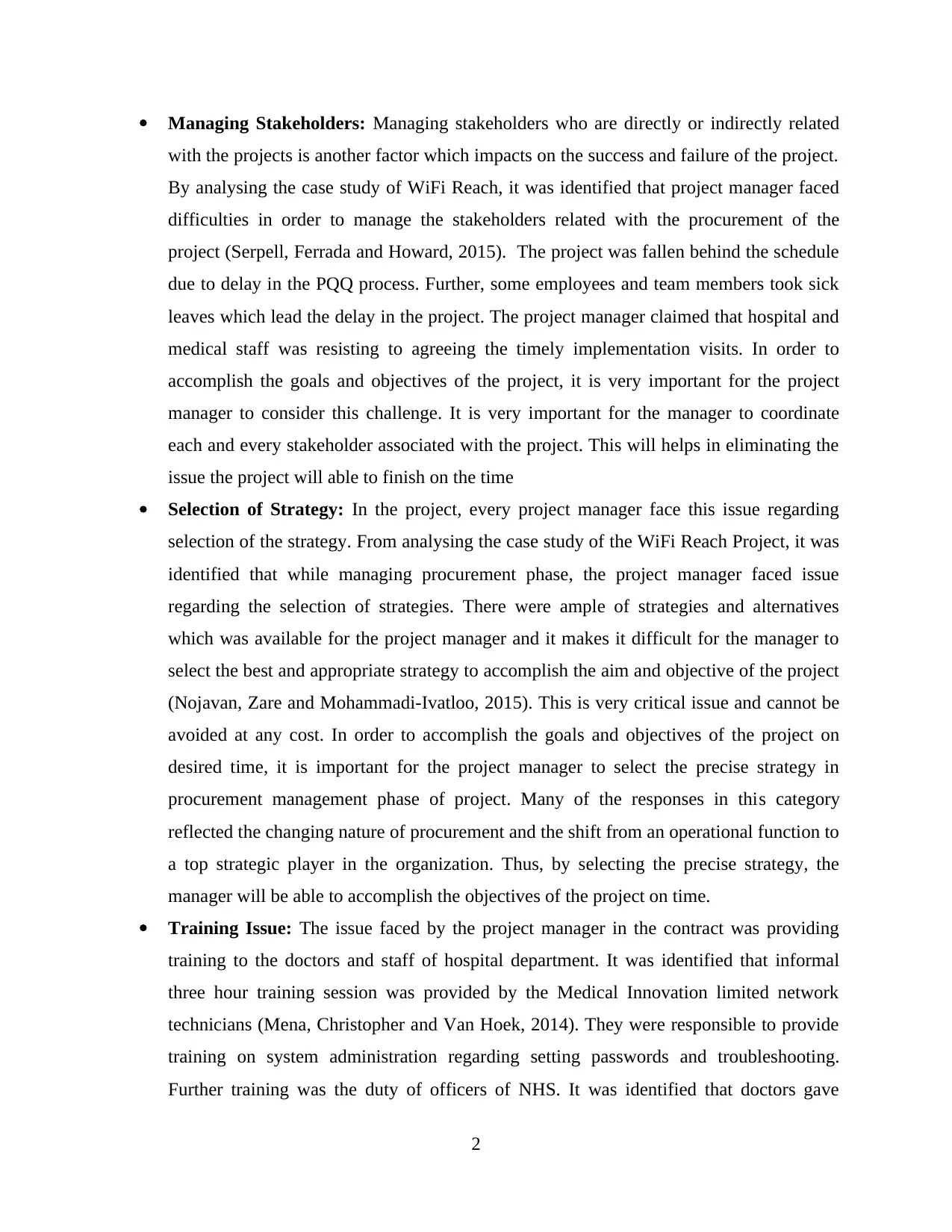
Managing Stakeholders: Managing stakeholders who are directly or indirectly related
with the projects is another factor which impacts on the success and failure of the project.
By analysing the case study of WiFi Reach, it was identified that project manager faced
difficulties in order to manage the stakeholders related with the procurement of the
project (Serpell, Ferrada and Howard, 2015). The project was fallen behind the schedule
due to delay in the PQQ process. Further, some employees and team members took sick
leaves which lead the delay in the project. The project manager claimed that hospital and
medical staff was resisting to agreeing the timely implementation visits. In order to
accomplish the goals and objectives of the project, it is very important for the project
manager to consider this challenge. It is very important for the manager to coordinate
each and every stakeholder associated with the project. This will helps in eliminating the
issue the project will able to finish on the time
Selection of Strategy: In the project, every project manager face this issue regarding
selection of the strategy. From analysing the case study of the WiFi Reach Project, it was
identified that while managing procurement phase, the project manager faced issue
regarding the selection of strategies. There were ample of strategies and alternatives
which was available for the project manager and it makes it difficult for the manager to
select the best and appropriate strategy to accomplish the aim and objective of the project
(Nojavan, Zare and Mohammadi-Ivatloo, 2015). This is very critical issue and cannot be
avoided at any cost. In order to accomplish the goals and objectives of the project on
desired time, it is important for the project manager to select the precise strategy in
procurement management phase of project. Many of the responses in this category
reflected the changing nature of procurement and the shift from an operational function to
a top strategic player in the organization. Thus, by selecting the precise strategy, the
manager will be able to accomplish the objectives of the project on time.
Training Issue: The issue faced by the project manager in the contract was providing
training to the doctors and staff of hospital department. It was identified that informal
three hour training session was provided by the Medical Innovation limited network
technicians (Mena, Christopher and Van Hoek, 2014). They were responsible to provide
training on system administration regarding setting passwords and troubleshooting.
Further training was the duty of officers of NHS. It was identified that doctors gave
2
with the projects is another factor which impacts on the success and failure of the project.
By analysing the case study of WiFi Reach, it was identified that project manager faced
difficulties in order to manage the stakeholders related with the procurement of the
project (Serpell, Ferrada and Howard, 2015). The project was fallen behind the schedule
due to delay in the PQQ process. Further, some employees and team members took sick
leaves which lead the delay in the project. The project manager claimed that hospital and
medical staff was resisting to agreeing the timely implementation visits. In order to
accomplish the goals and objectives of the project, it is very important for the project
manager to consider this challenge. It is very important for the manager to coordinate
each and every stakeholder associated with the project. This will helps in eliminating the
issue the project will able to finish on the time
Selection of Strategy: In the project, every project manager face this issue regarding
selection of the strategy. From analysing the case study of the WiFi Reach Project, it was
identified that while managing procurement phase, the project manager faced issue
regarding the selection of strategies. There were ample of strategies and alternatives
which was available for the project manager and it makes it difficult for the manager to
select the best and appropriate strategy to accomplish the aim and objective of the project
(Nojavan, Zare and Mohammadi-Ivatloo, 2015). This is very critical issue and cannot be
avoided at any cost. In order to accomplish the goals and objectives of the project on
desired time, it is important for the project manager to select the precise strategy in
procurement management phase of project. Many of the responses in this category
reflected the changing nature of procurement and the shift from an operational function to
a top strategic player in the organization. Thus, by selecting the precise strategy, the
manager will be able to accomplish the objectives of the project on time.
Training Issue: The issue faced by the project manager in the contract was providing
training to the doctors and staff of hospital department. It was identified that informal
three hour training session was provided by the Medical Innovation limited network
technicians (Mena, Christopher and Van Hoek, 2014). They were responsible to provide
training on system administration regarding setting passwords and troubleshooting.
Further training was the duty of officers of NHS. It was identified that doctors gave
2
Paraphrase This Document
Need a fresh take? Get an instant paraphrase of this document with our AI Paraphraser
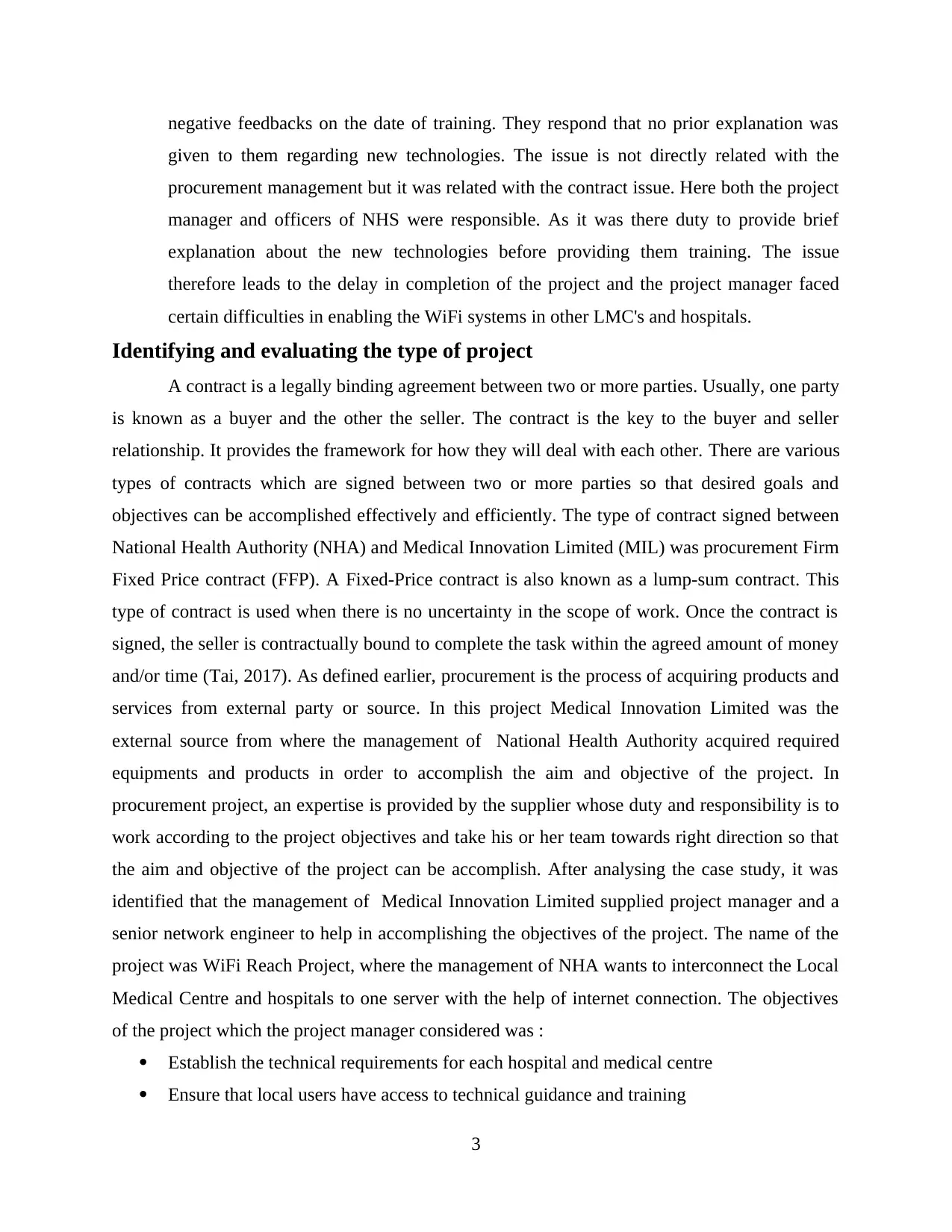
negative feedbacks on the date of training. They respond that no prior explanation was
given to them regarding new technologies. The issue is not directly related with the
procurement management but it was related with the contract issue. Here both the project
manager and officers of NHS were responsible. As it was there duty to provide brief
explanation about the new technologies before providing them training. The issue
therefore leads to the delay in completion of the project and the project manager faced
certain difficulties in enabling the WiFi systems in other LMC's and hospitals.
Identifying and evaluating the type of project
A contract is a legally binding agreement between two or more parties. Usually, one party
is known as a buyer and the other the seller. The contract is the key to the buyer and seller
relationship. It provides the framework for how they will deal with each other. There are various
types of contracts which are signed between two or more parties so that desired goals and
objectives can be accomplished effectively and efficiently. The type of contract signed between
National Health Authority (NHA) and Medical Innovation Limited (MIL) was procurement Firm
Fixed Price contract (FFP). A Fixed-Price contract is also known as a lump-sum contract. This
type of contract is used when there is no uncertainty in the scope of work. Once the contract is
signed, the seller is contractually bound to complete the task within the agreed amount of money
and/or time (Tai, 2017). As defined earlier, procurement is the process of acquiring products and
services from external party or source. In this project Medical Innovation Limited was the
external source from where the management of National Health Authority acquired required
equipments and products in order to accomplish the aim and objective of the project. In
procurement project, an expertise is provided by the supplier whose duty and responsibility is to
work according to the project objectives and take his or her team towards right direction so that
the aim and objective of the project can be accomplish. After analysing the case study, it was
identified that the management of Medical Innovation Limited supplied project manager and a
senior network engineer to help in accomplishing the objectives of the project. The name of the
project was WiFi Reach Project, where the management of NHA wants to interconnect the Local
Medical Centre and hospitals to one server with the help of internet connection. The objectives
of the project which the project manager considered was :
Establish the technical requirements for each hospital and medical centre
Ensure that local users have access to technical guidance and training
3
given to them regarding new technologies. The issue is not directly related with the
procurement management but it was related with the contract issue. Here both the project
manager and officers of NHS were responsible. As it was there duty to provide brief
explanation about the new technologies before providing them training. The issue
therefore leads to the delay in completion of the project and the project manager faced
certain difficulties in enabling the WiFi systems in other LMC's and hospitals.
Identifying and evaluating the type of project
A contract is a legally binding agreement between two or more parties. Usually, one party
is known as a buyer and the other the seller. The contract is the key to the buyer and seller
relationship. It provides the framework for how they will deal with each other. There are various
types of contracts which are signed between two or more parties so that desired goals and
objectives can be accomplished effectively and efficiently. The type of contract signed between
National Health Authority (NHA) and Medical Innovation Limited (MIL) was procurement Firm
Fixed Price contract (FFP). A Fixed-Price contract is also known as a lump-sum contract. This
type of contract is used when there is no uncertainty in the scope of work. Once the contract is
signed, the seller is contractually bound to complete the task within the agreed amount of money
and/or time (Tai, 2017). As defined earlier, procurement is the process of acquiring products and
services from external party or source. In this project Medical Innovation Limited was the
external source from where the management of National Health Authority acquired required
equipments and products in order to accomplish the aim and objective of the project. In
procurement project, an expertise is provided by the supplier whose duty and responsibility is to
work according to the project objectives and take his or her team towards right direction so that
the aim and objective of the project can be accomplish. After analysing the case study, it was
identified that the management of Medical Innovation Limited supplied project manager and a
senior network engineer to help in accomplishing the objectives of the project. The name of the
project was WiFi Reach Project, where the management of NHA wants to interconnect the Local
Medical Centre and hospitals to one server with the help of internet connection. The objectives
of the project which the project manager considered was :
Establish the technical requirements for each hospital and medical centre
Ensure that local users have access to technical guidance and training
3

Co-ordinate implementation and security issues
Track and monitor progress of connections, usage and project costs
Achieve government connection targets
Provide support where local implementation difficulties are encountered.
The procurement contract signed between NHA and MIL was WiFi Reach Project. The motive
of the project is to connect each and every Local Medical Centre and hospitals with the help of
internet. Procurement assists the organisation to share the opportunities, hiring expertise and
buying goods and services in the organisation. Thus, with the helps of procurement contract, the
management will be able to accomplish the desired goals and objectives of the project effectively
and efficiently (Fernandes and Vieira, 2015). There are various advantages and disadvantages of
this fixed price contract. It helps in managing the cost of contract. In the project, managing cost
is one of the important issue which is to be consider by the project manager in order to
accomplish the goals and objectives of the project. It further assists in eliminating potential
disagreements. The contract is static and has very little room for argument thus, helps in
obliterating potential disagreements. It helps in controlling the effort level. The fixed price
agreement can help in controlling the professionalism a contractor must exercise while working
in the agreement. This increases the effectiveness in the control level and help the parties to
contract to complete their project on time. The disadvantages associated with the fixed price
contract is that it is higher in cost as compared to other contracts. The future predictability
increases and the negotiation in the contract decreases thus, increases the overall value of the
contract. The contract further, will not be able to change as per the changes in market. Market
forces either increases or decreases the prices of raw materials and thus it negatively impacts on
the contract. Here the contract fails to stands on the needs and expectation of the parties. From
the above evaluation it can be understood that the contract signed between NHA and MIL was
Fixed-price contract of procurement and it has various advantages and disadvantages associated
with it.
Recommendations to address key problems
From the analysis of the case study and procurement management process, it was
identified that several issues bother the project manager while conducting the project of
implementing network technology and wireless systems in hospitals and local medical centres.
Below are the recommendations and suggested transformation in terms and condition of the
4
Track and monitor progress of connections, usage and project costs
Achieve government connection targets
Provide support where local implementation difficulties are encountered.
The procurement contract signed between NHA and MIL was WiFi Reach Project. The motive
of the project is to connect each and every Local Medical Centre and hospitals with the help of
internet. Procurement assists the organisation to share the opportunities, hiring expertise and
buying goods and services in the organisation. Thus, with the helps of procurement contract, the
management will be able to accomplish the desired goals and objectives of the project effectively
and efficiently (Fernandes and Vieira, 2015). There are various advantages and disadvantages of
this fixed price contract. It helps in managing the cost of contract. In the project, managing cost
is one of the important issue which is to be consider by the project manager in order to
accomplish the goals and objectives of the project. It further assists in eliminating potential
disagreements. The contract is static and has very little room for argument thus, helps in
obliterating potential disagreements. It helps in controlling the effort level. The fixed price
agreement can help in controlling the professionalism a contractor must exercise while working
in the agreement. This increases the effectiveness in the control level and help the parties to
contract to complete their project on time. The disadvantages associated with the fixed price
contract is that it is higher in cost as compared to other contracts. The future predictability
increases and the negotiation in the contract decreases thus, increases the overall value of the
contract. The contract further, will not be able to change as per the changes in market. Market
forces either increases or decreases the prices of raw materials and thus it negatively impacts on
the contract. Here the contract fails to stands on the needs and expectation of the parties. From
the above evaluation it can be understood that the contract signed between NHA and MIL was
Fixed-price contract of procurement and it has various advantages and disadvantages associated
with it.
Recommendations to address key problems
From the analysis of the case study and procurement management process, it was
identified that several issues bother the project manager while conducting the project of
implementing network technology and wireless systems in hospitals and local medical centres.
Below are the recommendations and suggested transformation in terms and condition of the
4
⊘ This is a preview!⊘
Do you want full access?
Subscribe today to unlock all pages.

Trusted by 1+ million students worldwide
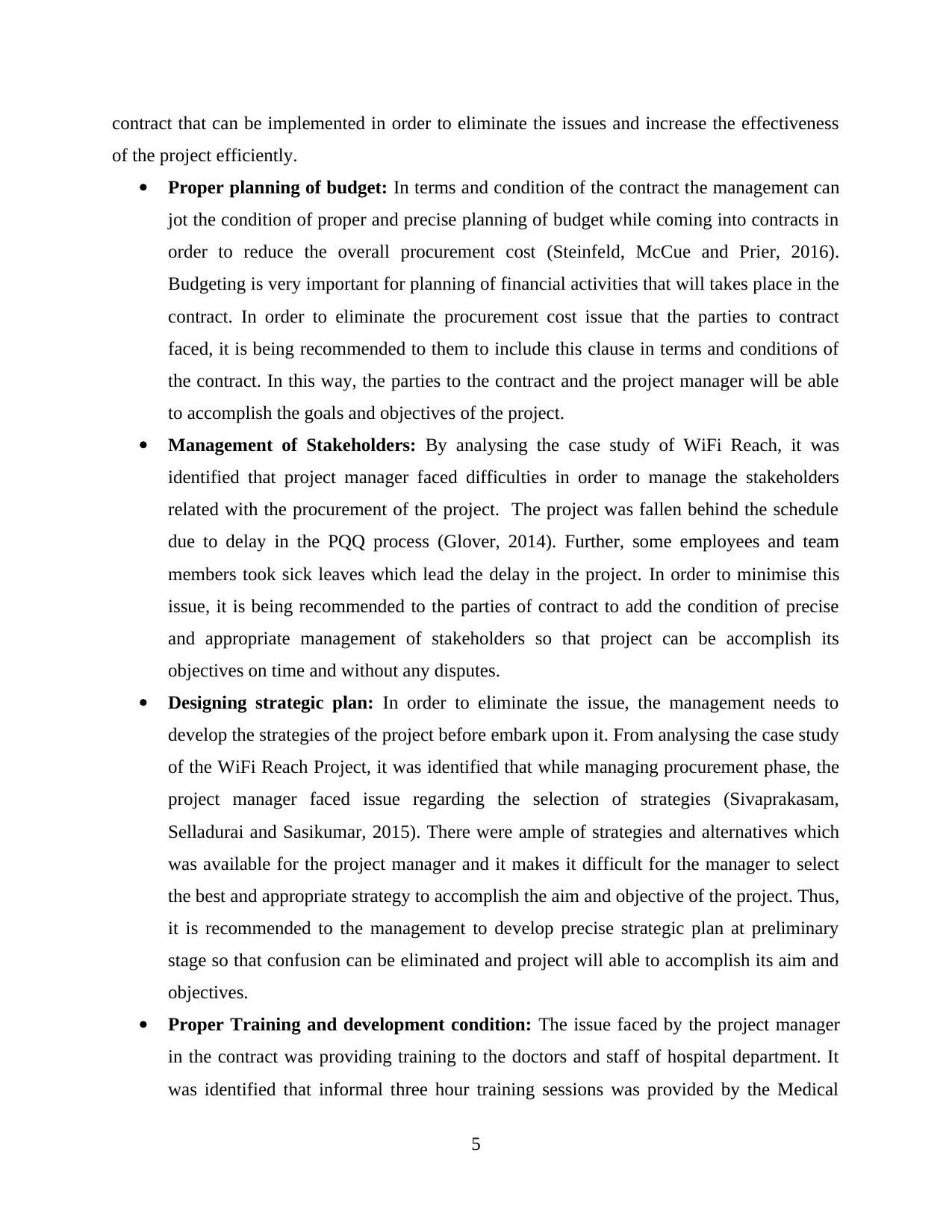
contract that can be implemented in order to eliminate the issues and increase the effectiveness
of the project efficiently.
Proper planning of budget: In terms and condition of the contract the management can
jot the condition of proper and precise planning of budget while coming into contracts in
order to reduce the overall procurement cost (Steinfeld, McCue and Prier, 2016).
Budgeting is very important for planning of financial activities that will takes place in the
contract. In order to eliminate the procurement cost issue that the parties to contract
faced, it is being recommended to them to include this clause in terms and conditions of
the contract. In this way, the parties to the contract and the project manager will be able
to accomplish the goals and objectives of the project.
Management of Stakeholders: By analysing the case study of WiFi Reach, it was
identified that project manager faced difficulties in order to manage the stakeholders
related with the procurement of the project. The project was fallen behind the schedule
due to delay in the PQQ process (Glover, 2014). Further, some employees and team
members took sick leaves which lead the delay in the project. In order to minimise this
issue, it is being recommended to the parties of contract to add the condition of precise
and appropriate management of stakeholders so that project can be accomplish its
objectives on time and without any disputes.
Designing strategic plan: In order to eliminate the issue, the management needs to
develop the strategies of the project before embark upon it. From analysing the case study
of the WiFi Reach Project, it was identified that while managing procurement phase, the
project manager faced issue regarding the selection of strategies (Sivaprakasam,
Selladurai and Sasikumar, 2015). There were ample of strategies and alternatives which
was available for the project manager and it makes it difficult for the manager to select
the best and appropriate strategy to accomplish the aim and objective of the project. Thus,
it is recommended to the management to develop precise strategic plan at preliminary
stage so that confusion can be eliminated and project will able to accomplish its aim and
objectives.
Proper Training and development condition: The issue faced by the project manager
in the contract was providing training to the doctors and staff of hospital department. It
was identified that informal three hour training sessions was provided by the Medical
5
of the project efficiently.
Proper planning of budget: In terms and condition of the contract the management can
jot the condition of proper and precise planning of budget while coming into contracts in
order to reduce the overall procurement cost (Steinfeld, McCue and Prier, 2016).
Budgeting is very important for planning of financial activities that will takes place in the
contract. In order to eliminate the procurement cost issue that the parties to contract
faced, it is being recommended to them to include this clause in terms and conditions of
the contract. In this way, the parties to the contract and the project manager will be able
to accomplish the goals and objectives of the project.
Management of Stakeholders: By analysing the case study of WiFi Reach, it was
identified that project manager faced difficulties in order to manage the stakeholders
related with the procurement of the project. The project was fallen behind the schedule
due to delay in the PQQ process (Glover, 2014). Further, some employees and team
members took sick leaves which lead the delay in the project. In order to minimise this
issue, it is being recommended to the parties of contract to add the condition of precise
and appropriate management of stakeholders so that project can be accomplish its
objectives on time and without any disputes.
Designing strategic plan: In order to eliminate the issue, the management needs to
develop the strategies of the project before embark upon it. From analysing the case study
of the WiFi Reach Project, it was identified that while managing procurement phase, the
project manager faced issue regarding the selection of strategies (Sivaprakasam,
Selladurai and Sasikumar, 2015). There were ample of strategies and alternatives which
was available for the project manager and it makes it difficult for the manager to select
the best and appropriate strategy to accomplish the aim and objective of the project. Thus,
it is recommended to the management to develop precise strategic plan at preliminary
stage so that confusion can be eliminated and project will able to accomplish its aim and
objectives.
Proper Training and development condition: The issue faced by the project manager
in the contract was providing training to the doctors and staff of hospital department. It
was identified that informal three hour training sessions was provided by the Medical
5
Paraphrase This Document
Need a fresh take? Get an instant paraphrase of this document with our AI Paraphraser
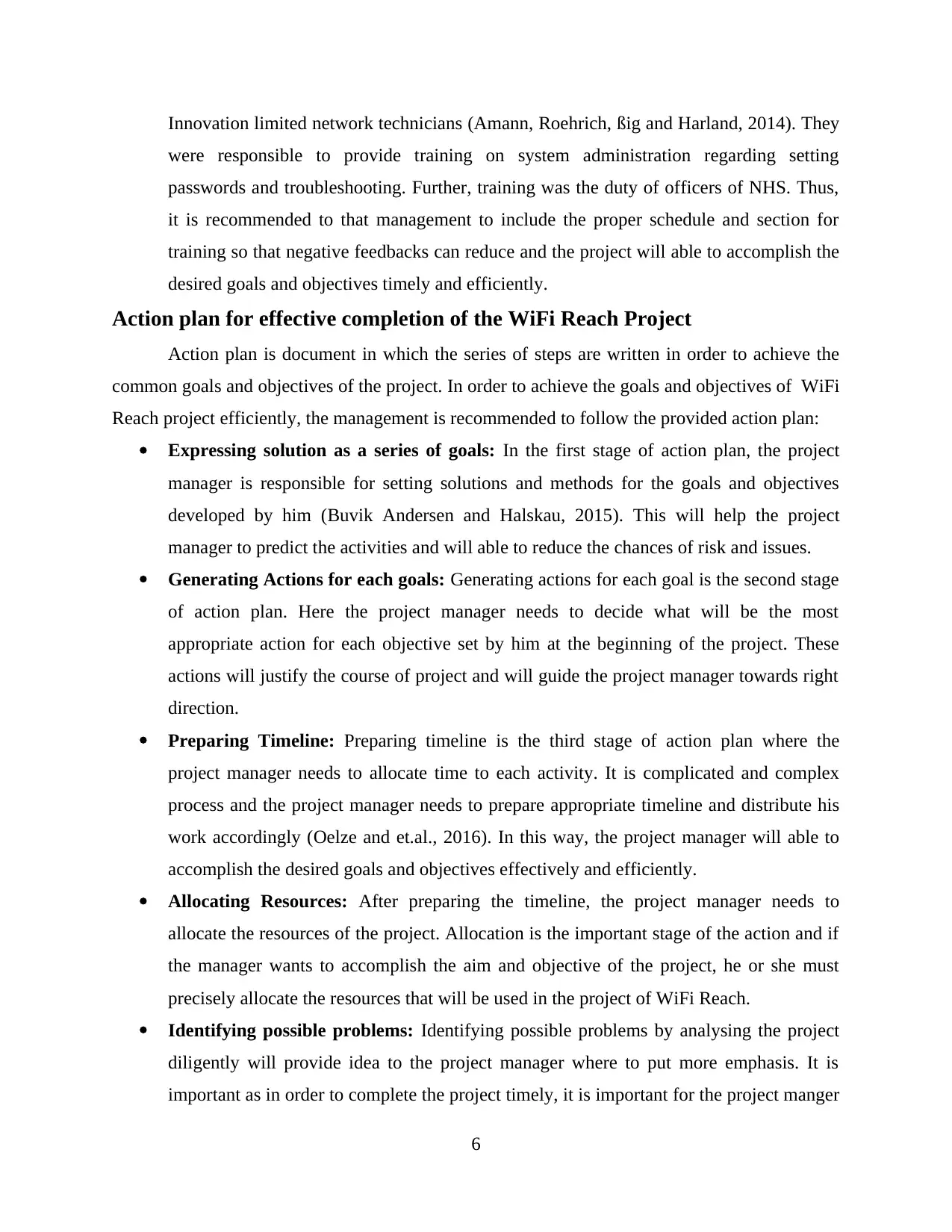
Innovation limited network technicians (Amann, Roehrich, ßig and Harland, 2014). They
were responsible to provide training on system administration regarding setting
passwords and troubleshooting. Further, training was the duty of officers of NHS. Thus,
it is recommended to that management to include the proper schedule and section for
training so that negative feedbacks can reduce and the project will able to accomplish the
desired goals and objectives timely and efficiently.
Action plan for effective completion of the WiFi Reach Project
Action plan is document in which the series of steps are written in order to achieve the
common goals and objectives of the project. In order to achieve the goals and objectives of WiFi
Reach project efficiently, the management is recommended to follow the provided action plan:
Expressing solution as a series of goals: In the first stage of action plan, the project
manager is responsible for setting solutions and methods for the goals and objectives
developed by him (Buvik Andersen and Halskau, 2015). This will help the project
manager to predict the activities and will able to reduce the chances of risk and issues.
Generating Actions for each goals: Generating actions for each goal is the second stage
of action plan. Here the project manager needs to decide what will be the most
appropriate action for each objective set by him at the beginning of the project. These
actions will justify the course of project and will guide the project manager towards right
direction.
Preparing Timeline: Preparing timeline is the third stage of action plan where the
project manager needs to allocate time to each activity. It is complicated and complex
process and the project manager needs to prepare appropriate timeline and distribute his
work accordingly (Oelze and et.al., 2016). In this way, the project manager will able to
accomplish the desired goals and objectives effectively and efficiently.
Allocating Resources: After preparing the timeline, the project manager needs to
allocate the resources of the project. Allocation is the important stage of the action and if
the manager wants to accomplish the aim and objective of the project, he or she must
precisely allocate the resources that will be used in the project of WiFi Reach.
Identifying possible problems: Identifying possible problems by analysing the project
diligently will provide idea to the project manager where to put more emphasis. It is
important as in order to complete the project timely, it is important for the project manger
6
were responsible to provide training on system administration regarding setting
passwords and troubleshooting. Further, training was the duty of officers of NHS. Thus,
it is recommended to that management to include the proper schedule and section for
training so that negative feedbacks can reduce and the project will able to accomplish the
desired goals and objectives timely and efficiently.
Action plan for effective completion of the WiFi Reach Project
Action plan is document in which the series of steps are written in order to achieve the
common goals and objectives of the project. In order to achieve the goals and objectives of WiFi
Reach project efficiently, the management is recommended to follow the provided action plan:
Expressing solution as a series of goals: In the first stage of action plan, the project
manager is responsible for setting solutions and methods for the goals and objectives
developed by him (Buvik Andersen and Halskau, 2015). This will help the project
manager to predict the activities and will able to reduce the chances of risk and issues.
Generating Actions for each goals: Generating actions for each goal is the second stage
of action plan. Here the project manager needs to decide what will be the most
appropriate action for each objective set by him at the beginning of the project. These
actions will justify the course of project and will guide the project manager towards right
direction.
Preparing Timeline: Preparing timeline is the third stage of action plan where the
project manager needs to allocate time to each activity. It is complicated and complex
process and the project manager needs to prepare appropriate timeline and distribute his
work accordingly (Oelze and et.al., 2016). In this way, the project manager will able to
accomplish the desired goals and objectives effectively and efficiently.
Allocating Resources: After preparing the timeline, the project manager needs to
allocate the resources of the project. Allocation is the important stage of the action and if
the manager wants to accomplish the aim and objective of the project, he or she must
precisely allocate the resources that will be used in the project of WiFi Reach.
Identifying possible problems: Identifying possible problems by analysing the project
diligently will provide idea to the project manager where to put more emphasis. It is
important as in order to complete the project timely, it is important for the project manger
6
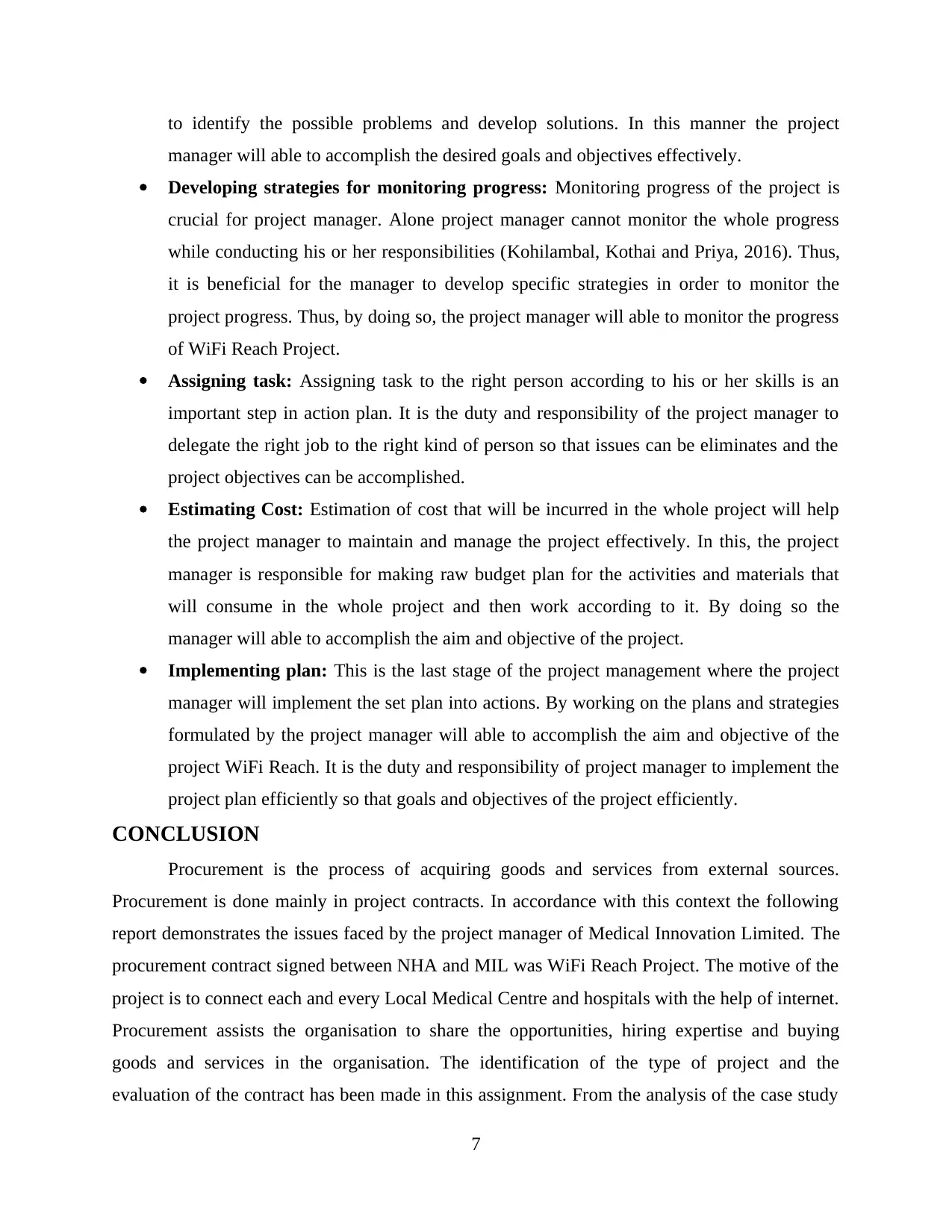
to identify the possible problems and develop solutions. In this manner the project
manager will able to accomplish the desired goals and objectives effectively.
Developing strategies for monitoring progress: Monitoring progress of the project is
crucial for project manager. Alone project manager cannot monitor the whole progress
while conducting his or her responsibilities (Kohilambal, Kothai and Priya, 2016). Thus,
it is beneficial for the manager to develop specific strategies in order to monitor the
project progress. Thus, by doing so, the project manager will able to monitor the progress
of WiFi Reach Project.
Assigning task: Assigning task to the right person according to his or her skills is an
important step in action plan. It is the duty and responsibility of the project manager to
delegate the right job to the right kind of person so that issues can be eliminates and the
project objectives can be accomplished.
Estimating Cost: Estimation of cost that will be incurred in the whole project will help
the project manager to maintain and manage the project effectively. In this, the project
manager is responsible for making raw budget plan for the activities and materials that
will consume in the whole project and then work according to it. By doing so the
manager will able to accomplish the aim and objective of the project.
Implementing plan: This is the last stage of the project management where the project
manager will implement the set plan into actions. By working on the plans and strategies
formulated by the project manager will able to accomplish the aim and objective of the
project WiFi Reach. It is the duty and responsibility of project manager to implement the
project plan efficiently so that goals and objectives of the project efficiently.
CONCLUSION
Procurement is the process of acquiring goods and services from external sources.
Procurement is done mainly in project contracts. In accordance with this context the following
report demonstrates the issues faced by the project manager of Medical Innovation Limited. The
procurement contract signed between NHA and MIL was WiFi Reach Project. The motive of the
project is to connect each and every Local Medical Centre and hospitals with the help of internet.
Procurement assists the organisation to share the opportunities, hiring expertise and buying
goods and services in the organisation. The identification of the type of project and the
evaluation of the contract has been made in this assignment. From the analysis of the case study
7
manager will able to accomplish the desired goals and objectives effectively.
Developing strategies for monitoring progress: Monitoring progress of the project is
crucial for project manager. Alone project manager cannot monitor the whole progress
while conducting his or her responsibilities (Kohilambal, Kothai and Priya, 2016). Thus,
it is beneficial for the manager to develop specific strategies in order to monitor the
project progress. Thus, by doing so, the project manager will able to monitor the progress
of WiFi Reach Project.
Assigning task: Assigning task to the right person according to his or her skills is an
important step in action plan. It is the duty and responsibility of the project manager to
delegate the right job to the right kind of person so that issues can be eliminates and the
project objectives can be accomplished.
Estimating Cost: Estimation of cost that will be incurred in the whole project will help
the project manager to maintain and manage the project effectively. In this, the project
manager is responsible for making raw budget plan for the activities and materials that
will consume in the whole project and then work according to it. By doing so the
manager will able to accomplish the aim and objective of the project.
Implementing plan: This is the last stage of the project management where the project
manager will implement the set plan into actions. By working on the plans and strategies
formulated by the project manager will able to accomplish the aim and objective of the
project WiFi Reach. It is the duty and responsibility of project manager to implement the
project plan efficiently so that goals and objectives of the project efficiently.
CONCLUSION
Procurement is the process of acquiring goods and services from external sources.
Procurement is done mainly in project contracts. In accordance with this context the following
report demonstrates the issues faced by the project manager of Medical Innovation Limited. The
procurement contract signed between NHA and MIL was WiFi Reach Project. The motive of the
project is to connect each and every Local Medical Centre and hospitals with the help of internet.
Procurement assists the organisation to share the opportunities, hiring expertise and buying
goods and services in the organisation. The identification of the type of project and the
evaluation of the contract has been made in this assignment. From the analysis of the case study
7
⊘ This is a preview!⊘
Do you want full access?
Subscribe today to unlock all pages.

Trusted by 1+ million students worldwide

and procurement management process, it was identified that several issues bother the project
manager while conducting the project of implementing network technology and wireless systems
in hospitals and local medical centres. In this context, the recommendations has been provided
and on the basis of it action plan has been formulated in this assignment. By following the action
plan, the management will able to accomplish the aim and objective of the project.
8
manager while conducting the project of implementing network technology and wireless systems
in hospitals and local medical centres. In this context, the recommendations has been provided
and on the basis of it action plan has been formulated in this assignment. By following the action
plan, the management will able to accomplish the aim and objective of the project.
8
Paraphrase This Document
Need a fresh take? Get an instant paraphrase of this document with our AI Paraphraser
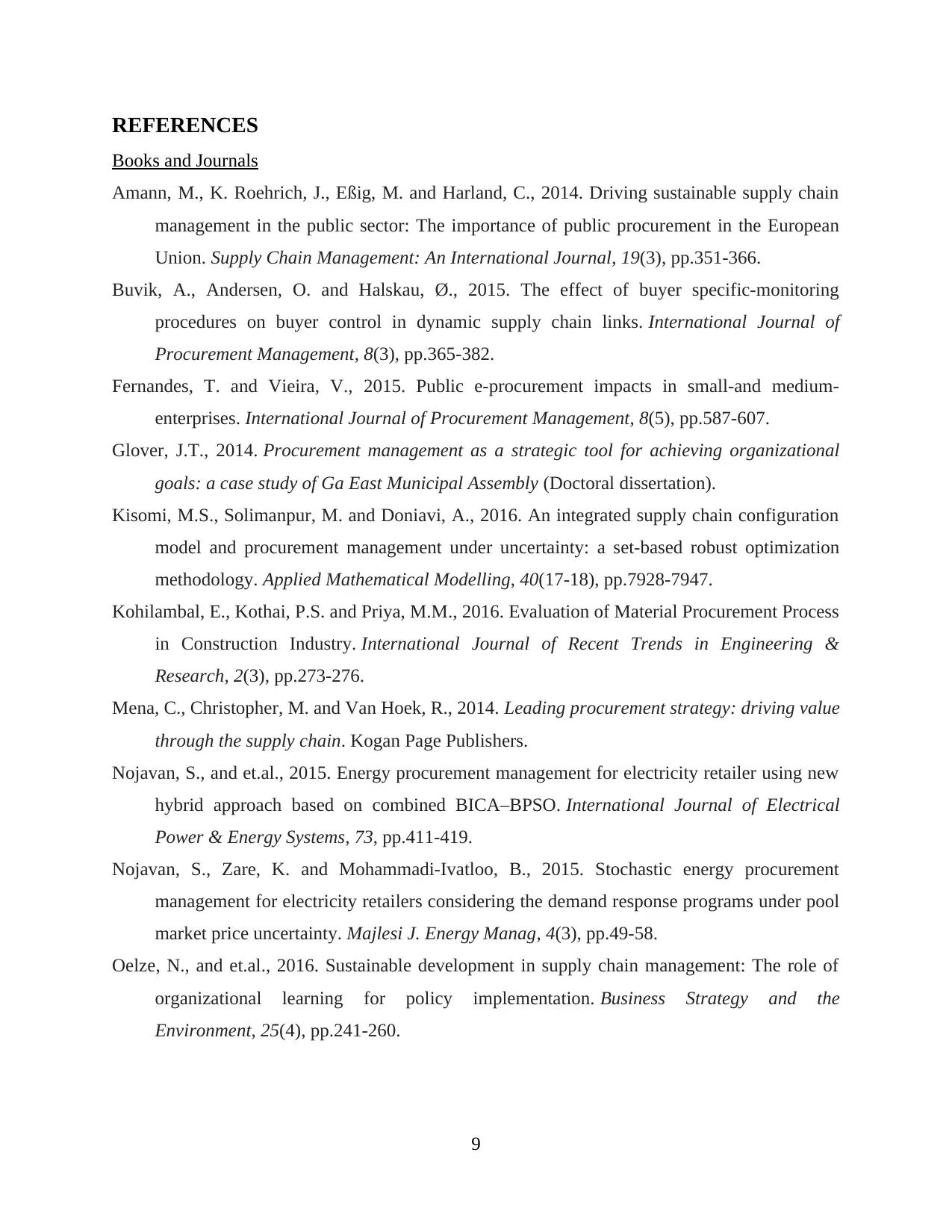
REFERENCES
Books and Journals
Amann, M., K. Roehrich, J., Eßig, M. and Harland, C., 2014. Driving sustainable supply chain
management in the public sector: The importance of public procurement in the European
Union. Supply Chain Management: An International Journal, 19(3), pp.351-366.
Buvik, A., Andersen, O. and Halskau, Ø., 2015. The effect of buyer specific-monitoring
procedures on buyer control in dynamic supply chain links. International Journal of
Procurement Management, 8(3), pp.365-382.
Fernandes, T. and Vieira, V., 2015. Public e-procurement impacts in small-and medium-
enterprises. International Journal of Procurement Management, 8(5), pp.587-607.
Glover, J.T., 2014. Procurement management as a strategic tool for achieving organizational
goals: a case study of Ga East Municipal Assembly (Doctoral dissertation).
Kisomi, M.S., Solimanpur, M. and Doniavi, A., 2016. An integrated supply chain configuration
model and procurement management under uncertainty: a set-based robust optimization
methodology. Applied Mathematical Modelling, 40(17-18), pp.7928-7947.
Kohilambal, E., Kothai, P.S. and Priya, M.M., 2016. Evaluation of Material Procurement Process
in Construction Industry. International Journal of Recent Trends in Engineering &
Research, 2(3), pp.273-276.
Mena, C., Christopher, M. and Van Hoek, R., 2014. Leading procurement strategy: driving value
through the supply chain. Kogan Page Publishers.
Nojavan, S., and et.al., 2015. Energy procurement management for electricity retailer using new
hybrid approach based on combined BICA–BPSO. International Journal of Electrical
Power & Energy Systems, 73, pp.411-419.
Nojavan, S., Zare, K. and Mohammadi-Ivatloo, B., 2015. Stochastic energy procurement
management for electricity retailers considering the demand response programs under pool
market price uncertainty. Majlesi J. Energy Manag, 4(3), pp.49-58.
Oelze, N., and et.al., 2016. Sustainable development in supply chain management: The role of
organizational learning for policy implementation. Business Strategy and the
Environment, 25(4), pp.241-260.
9
Books and Journals
Amann, M., K. Roehrich, J., Eßig, M. and Harland, C., 2014. Driving sustainable supply chain
management in the public sector: The importance of public procurement in the European
Union. Supply Chain Management: An International Journal, 19(3), pp.351-366.
Buvik, A., Andersen, O. and Halskau, Ø., 2015. The effect of buyer specific-monitoring
procedures on buyer control in dynamic supply chain links. International Journal of
Procurement Management, 8(3), pp.365-382.
Fernandes, T. and Vieira, V., 2015. Public e-procurement impacts in small-and medium-
enterprises. International Journal of Procurement Management, 8(5), pp.587-607.
Glover, J.T., 2014. Procurement management as a strategic tool for achieving organizational
goals: a case study of Ga East Municipal Assembly (Doctoral dissertation).
Kisomi, M.S., Solimanpur, M. and Doniavi, A., 2016. An integrated supply chain configuration
model and procurement management under uncertainty: a set-based robust optimization
methodology. Applied Mathematical Modelling, 40(17-18), pp.7928-7947.
Kohilambal, E., Kothai, P.S. and Priya, M.M., 2016. Evaluation of Material Procurement Process
in Construction Industry. International Journal of Recent Trends in Engineering &
Research, 2(3), pp.273-276.
Mena, C., Christopher, M. and Van Hoek, R., 2014. Leading procurement strategy: driving value
through the supply chain. Kogan Page Publishers.
Nojavan, S., and et.al., 2015. Energy procurement management for electricity retailer using new
hybrid approach based on combined BICA–BPSO. International Journal of Electrical
Power & Energy Systems, 73, pp.411-419.
Nojavan, S., Zare, K. and Mohammadi-Ivatloo, B., 2015. Stochastic energy procurement
management for electricity retailers considering the demand response programs under pool
market price uncertainty. Majlesi J. Energy Manag, 4(3), pp.49-58.
Oelze, N., and et.al., 2016. Sustainable development in supply chain management: The role of
organizational learning for policy implementation. Business Strategy and the
Environment, 25(4), pp.241-260.
9
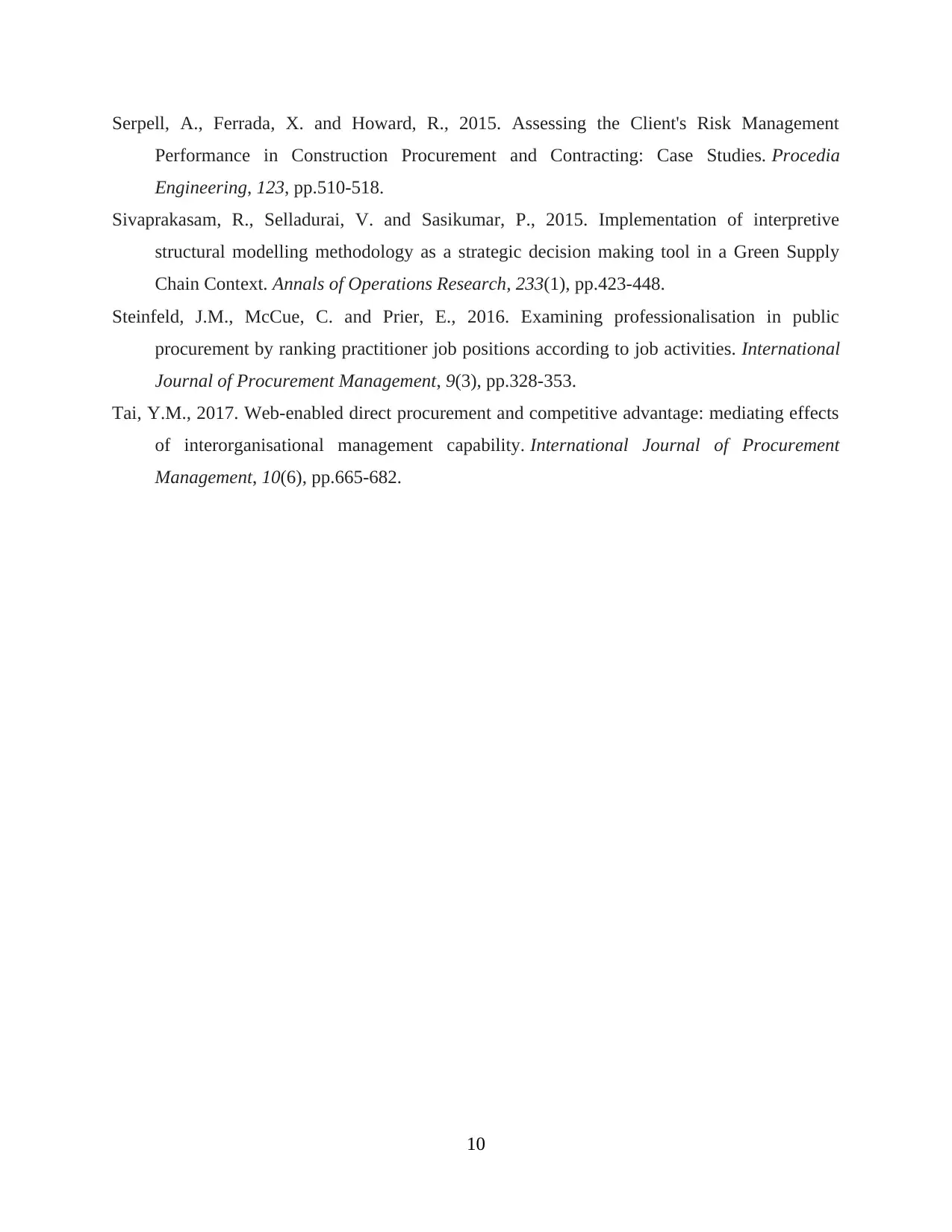
Serpell, A., Ferrada, X. and Howard, R., 2015. Assessing the Client's Risk Management
Performance in Construction Procurement and Contracting: Case Studies. Procedia
Engineering, 123, pp.510-518.
Sivaprakasam, R., Selladurai, V. and Sasikumar, P., 2015. Implementation of interpretive
structural modelling methodology as a strategic decision making tool in a Green Supply
Chain Context. Annals of Operations Research, 233(1), pp.423-448.
Steinfeld, J.M., McCue, C. and Prier, E., 2016. Examining professionalisation in public
procurement by ranking practitioner job positions according to job activities. International
Journal of Procurement Management, 9(3), pp.328-353.
Tai, Y.M., 2017. Web-enabled direct procurement and competitive advantage: mediating effects
of interorganisational management capability. International Journal of Procurement
Management, 10(6), pp.665-682.
10
Performance in Construction Procurement and Contracting: Case Studies. Procedia
Engineering, 123, pp.510-518.
Sivaprakasam, R., Selladurai, V. and Sasikumar, P., 2015. Implementation of interpretive
structural modelling methodology as a strategic decision making tool in a Green Supply
Chain Context. Annals of Operations Research, 233(1), pp.423-448.
Steinfeld, J.M., McCue, C. and Prier, E., 2016. Examining professionalisation in public
procurement by ranking practitioner job positions according to job activities. International
Journal of Procurement Management, 9(3), pp.328-353.
Tai, Y.M., 2017. Web-enabled direct procurement and competitive advantage: mediating effects
of interorganisational management capability. International Journal of Procurement
Management, 10(6), pp.665-682.
10
⊘ This is a preview!⊘
Do you want full access?
Subscribe today to unlock all pages.

Trusted by 1+ million students worldwide
1 out of 12
Related Documents
Your All-in-One AI-Powered Toolkit for Academic Success.
+13062052269
info@desklib.com
Available 24*7 on WhatsApp / Email
![[object Object]](/_next/static/media/star-bottom.7253800d.svg)
Unlock your academic potential
Copyright © 2020–2025 A2Z Services. All Rights Reserved. Developed and managed by ZUCOL.




